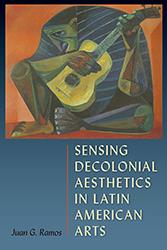Simón Bolívar
Travels and Transformations of a Cultural Icon
Edited by Maureen G. Shanahan and Ana María Reyes
Paper: $35.00
“These scholars make compelling cases for why each aspect of Bolívar’s life was so significant and how his life was used to develop the Bolívarian cult. . . . This book shows how important Bolívar was—and still is—in Venezuela, regardless of one’s political persuasion.”—Journal of Global South Studies
“The contributions are essential for any who seek interdisciplinary avenues between history and art, as well as for those who focus on independence movements and reconstructive nation building. And the collection is extremely useful as a tool for the study of Latin American history, politics, and art combined. Finally, as a study of Bolívar, it is exemplary in terms of how to conduct nuanced analysis of an iconic and mythological figure.”—caa.reviews
“A valuable contribution to the field of Bolivarian studies. . . . Students and specialists alike will find useful the documentary evidence and analyses these essays provide.”—Revista de Estudios Hispanicos
"Shows us how and why Simón Bolívar is still a major icon in Latin American culture. Cinema, politics, painting, literature, religion, and opera are all touched and marked by ‘El Libertador’ who is still very much an active force in Latin America."--Efraín Barradas, author of Mente, Mirada, Mano: Visiones y Revisiones de La Obra de Lorenzo Homar
"An indispensable resource for anyone interested in the myth and memory of Simón Bolívar."--Sibylle Fischer, author of Modernity Disavowed: Haiti and the Cultures of Slavery in the Age of Revolution
One of Latin America’s most famous historical figures, Simón Bolívar has become a mythic symbol for many nations, empires, and revolutions used to support wildly diverse--sometimes opposite--ideas. From colonial Cuba to Nazi-occupied France to Cold War-era Slovenia, the image of "El Libertador" has variously signified loyalty, national unity, liberation, freedom, and revolt.
In this volume, an array of international and interdisciplinary scholars shows the ways Bolívar has appeared over the last two centuries in painting, fiction, poetry, music, film, festival, dance, city planning, and even reliquary adoration. They illustrate how Bolívar’s body has been exalted, reimagined, or fragmented in different contexts, taking on a range of meanings to represent the politics and poetics of today’s national bodies.
By critically analyzing many examples of cultural Bolivarianisms, or cults of Bolívar, this collection demonstrates the capacity of the arts and humanities to challenge and reinvent hegemonic icons and narratives and, therefore, to be vital to democracy.
Maureen G. Shanahan is professor of art history at James Madison University. Ana María Reyes is assistant professor of Latin American art history at Boston University.
Contributors: Armida de la Garza| Luis Duno-Gottberg| Emily A. Engel| Alejandro E. Gomez Pernia| Juan de Dios Lopez Maya| Paul Niell| Tina Potocnik| Ana Maria Reyes| Alicia Rios| Nicholas Roberts| Maureen G. Shanahan| Juan Francisco Sans| Tomas Straka
- Sample Chapter(s):
- Table of Contents
- Excerpt
A valuable contribution to the field of Bolivarian studies. . . . Students and specialists alike will find useful the documentary evidence and analyses these essays provide.
--Revista de Estudios Hispanicos












